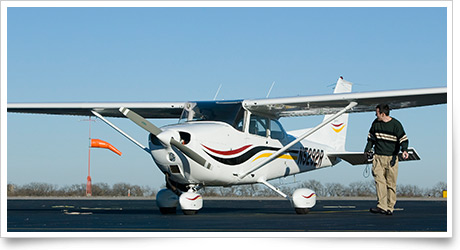| The following stories from the May 11, 2012, edition of AOPA ePilot were provided to AOPA members who expressed an interest in the particular subject areas. Any AOPA member can receive information tailored to their areas of interest by updating their preferences online |
training tipsA quick turn Even for this short stay, tie down the trainer, chock the wheels, and install control-wheel or gust locks before you head inside for a snack, to close your outbound VFR flight plan, and to update weather. Take time to review how you will activate the return flight plan. Will you contact a flight service station via a remote communications outlet (RCO)? Perhaps you’ll make radio contact on 122.1 MHz and listen on a voice-capable VOR. (Remember to turn up the volume on the nav frequency on which the FSS specialist will respond.) It’s good practice to remain with the aircraft to supervise the refueling—everything from the type and quantity of fuel to the handling of the aircraft by the crew—but that’s not always possible if there’s a wait in store. So be sure to perform a proper preflight inspection on your return to the aircraft. Take a fuel sample, visually checking the fuel and oil levels, and check the security of fuel tank caps. Don’t forget to remove that gust lock! Lapses have happened, and have sometimes attracted official attention. If delays are inevitable, avoid letting any imagined pressure lead you into a state of “get-home-itis,” described in the May 4 Training Tip. Giving in by making a hasty getaway could cause you to skip a weather update or pass on refueling—bad ideas indeed. Failing to perform thorough pre-takeoff checks doesn’t save much time, and it could cause you to miss a first alert to a mechanical problem. A much better strategy for arranging economical use of your ground time is to contact the destination FBO when inbound, giving an estimate of your time of arrival and stating your service needs. If you are receiving radar flight following, continue monitoring your assigned frequency, or, if that’s not possible, request ATC’s permission to leave the frequency briefly. A quick turn doesn’t mean a mad rush. Speeding you safely on your way is everyone’s goal. Tell people your needs, and they will deliver. training productsOnline Flight Instructor Refresher Clinic from King SchoolsFlight instructors have another option when it’s time to renew a CFI certificate. King Schools has unveiled its Flight Instructor Refresher Clinic, which claims to move away from the same topics that CFIs learned as private pilots and instead focuses on such issues as identifying and changing at-risk behaviors and conducting an effective flight review. The course incorporates a paperless online renewal process so that instructors can receive a temporary certificate by email. It is compatible with the iPad and all Windows and Mac Web browsers. The cost is $99 without CFI renewal processing or $124.95 with processing included. See the website or call 800/854-1001.
Note: Products listed have not been evaluated by ePilot editors unless otherwise noted. AOPA assumes no responsibility for products or services listed or for claims or actions by manufacturers or vendors. final examQuestion: I’m new to GPS navigation, and I’m not sure I understand RAIM. Can you explain?
Answer: RAIM stands for receiver autonomous integrity monitoring. It is a form of integrity monitoring that your GPS receiver performs to ensure that the required satellite signals are available for a given phase of flight. The RAIM function can identify a satellite failure and issue a warning to the pilot. Many VFR GPS receivers and most handheld receivers do not have RAIM capability, which is one reason they are not approved for IFR use. Without RAIM capability, the pilot has no idea whether the GPS position is accurate. At least five satellites are required to detect a bad one. The GPS receiver should also tell you when its RAIM function is unavailable, at your present time and position as well as at any selected future time and position. You can get information on satellite outages through the notam system; however, the effect of an outage on your intended operation cannot be determined unless your GPS has a RAIM availability prediction program that allows excluding a satellite that is predicted to be out of service. For more on GPS operations, take the Air Safety Institute online courses GPS for VFR Operations and GPS for IFR Operations .
Got a question for our technical services staff? Email [email protected] or call the Pilot Information Center, 800/872-2672. Don’t forget the online archive of “Final Exam” questions and answers, searchable by keyword or topic. |
 The wind is blowing smartly as you land at your cross-country destination, where you will take a break, refuel, and then depart for home. You encountered strong headwinds aloft, so now it will be helpful if the line crew would perform a
The wind is blowing smartly as you land at your cross-country destination, where you will take a break, refuel, and then depart for home. You encountered strong headwinds aloft, so now it will be helpful if the line crew would perform a 

